Nathaniel Hone RHA (1831-1917) Cattle at Malahide Oil on canvas, 61 x 91.5cm (24 x 36'') Provenance: Leo Smith (Dawson Gallery) Dublin, 29th November 1943 where purchased by J.P. Reihill Snr; Deepwell, Blackrock, Co. Dublin Nathaniel Hone was the first native artist to introduce the influence of 19th century French Naturalism to Irish painting. He was born in Fitzwilliam Place, Dublin in 1831, the son of Brindley Hone, a merchant and director of the Midland Great Western Railway and was the great-grandnephew of the 18th century painter of the same name. Though a member of this very artistic family, his initial training was as an engineer at Trinity College Dublin followed by a brief period of work for the Irish Railway before going to Paris in 1853, at the age of twenty-one to study painting. He first studied under Adolphe Yvon the French military painter and later Thomas Couture who was one of the earliest exponents of realism and from whom Hone learned principles which would influence his work throughout his career. Hone moved to the village of Barbizon in the Forest of Fontainebleau circa 1856, where he painted with Millet, Courbet, Daubigny and Harpignies. Corot's paintings had the greatest influence upon his work. The advice which Hone had absorbed from Couture to ''retain the brilliant qualities of a first painting'', were echoed by Corot in Barbizon: ''surrender to the first impression''. While based in Fontainebleau, Hone also made trips to Normandy, Brittany, the Mediterranean coast and briefly visited Italy. Wherever he travelled his subject matter was consistent, always choosing to observe the landscape and country life, in scenes of shepherds with their herds, fishing villages and the seashore. During his seventeen years in France, Hone made regular visits home before this final return in 1872. Within a few months he married Magdalen Jameson of the wealthy, distilling family and they settled near Malahide. The paintings which he completed in Ireland after his return from France maintain the mood and muted tonality characteristic of the Barbizon School. He chose similar subjects to those he had portrayed in France: woodlands, pastures and coastline; the major part of his output was of scenes around Dublin Bay although he also painted in Wicklow, Donegal, Mayo and Clare and made several trips abroad to Greece, Asia Minor and Egypt. From 1876, except for four years, Hone exhibited at the RHA. He was elected a full member in 1880 and in 1894 became Professor of Painting. His exhibition with John Butler Yeats in 1901 was one of the turning points for the history of Irish art as it was their paintings which convinced Sir Hugh Lane that Dublin should have a gallery of modern art. After his death in 1917 his widow bequeathed the contents of his studio to the National Gallery of Ireland. Hone rarely dated his work so that it is difficult to establish chronology. The similarity of many of his motifs and subjects often make it difficult to tell whether a view is Irish or French. Equally it is difficult to chart his developments on stylistic grounds alone. The olive silvery green tonality of this painting is particularly reminiscent of Corot as is its simplicity and broad treatment, especially in the foreground which is punctuated here and there with deft flickering brushstrokes depicting wild flowers and plants, a favourite device of Corot's. The warm brownish-pink undercoat or '�bauche' employed by Hone beneath the surface of the paint is here allowed to show through the thin green wash to portray the sandy nature of soil so close to the sea. The use of an �bauche, a technique which Hone learned from Couture, gives the painting a subdued tonality. The sky was as important to Hone as the land or seascape. His preference was for a low horizon which allowed him to engage with the prevailing weather conditions. Nathaniel Hone RHA (1831-1917) Cattle at Malahide Oil on canvas, 61 x 91.5cm (24 x 36'') Provenance: Leo Smith (Daw
Nathaniel Hone RHA (1831-1917) Cattle at Malahide Oil on canvas, 61 x 91.5cm (24 x 36'') Provenance: Leo Smith (Dawson Gallery) Dublin, 29th November 1943 where purchased by J.P. Reihill Snr; Deepwell, Blackrock, Co. Dublin Nathaniel Hone was the first native artist to introduce the influence of 19th century French Naturalism to Irish painting. He was born in Fitzwilliam Place, Dublin in 1831, the son of Brindley Hone, a merchant and director of the Midland Great Western Railway and was the great-grandnephew of the 18th century painter of the same name. Though a member of this very artistic family, his initial training was as an engineer at Trinity College Dublin followed by a brief period of work for the Irish Railway before going to Paris in 1853, at the age of twenty-one to study painting. He first studied under Adolphe Yvon the French military painter and later Thomas Couture who was one of the earliest exponents of realism and from whom Hone learned principles which would influence his work throughout his career. Hone moved to the village of Barbizon in the Forest of Fontainebleau circa 1856, where he painted with Millet, Courbet, Daubigny and Harpignies. Corot's paintings had the greatest influence upon his work. The advice which Hone had absorbed from Couture to ''retain the brilliant qualities of a first painting'', were echoed by Corot in Barbizon: ''surrender to the first impression''. While based in Fontainebleau, Hone also made trips to Normandy, Brittany, the Mediterranean coast and briefly visited Italy. Wherever he travelled his subject matter was consistent, always choosing to observe the landscape and country life, in scenes of shepherds with their herds, fishing villages and the seashore. During his seventeen years in France, Hone made regular visits home before this final return in 1872. Within a few months he married Magdalen Jameson of the wealthy, distilling family and they settled near Malahide. The paintings which he completed in Ireland after his return from France maintain the mood and muted tonality characteristic of the Barbizon School. He chose similar subjects to those he had portrayed in France: woodlands, pastures and coastline; the major part of his output was of scenes around Dublin Bay although he also painted in Wicklow, Donegal, Mayo and Clare and made several trips abroad to Greece, Asia Minor and Egypt. From 1876, except for four years, Hone exhibited at the RHA. He was elected a full member in 1880 and in 1894 became Professor of Painting. His exhibition with John Butler Yeats in 1901 was one of the turning points for the history of Irish art as it was their paintings which convinced Sir Hugh Lane that Dublin should have a gallery of modern art. After his death in 1917 his widow bequeathed the contents of his studio to the National Gallery of Ireland. Hone rarely dated his work so that it is difficult to establish chronology. The similarity of many of his motifs and subjects often make it difficult to tell whether a view is Irish or French. Equally it is difficult to chart his developments on stylistic grounds alone. The olive silvery green tonality of this painting is particularly reminiscent of Corot as is its simplicity and broad treatment, especially in the foreground which is punctuated here and there with deft flickering brushstrokes depicting wild flowers and plants, a favourite device of Corot's. The warm brownish-pink undercoat or '�bauche' employed by Hone beneath the surface of the paint is here allowed to show through the thin green wash to portray the sandy nature of soil so close to the sea. The use of an �bauche, a technique which Hone learned from Couture, gives the painting a subdued tonality. The sky was as important to Hone as the land or seascape. His preference was for a low horizon which allowed him to engage with the prevailing weather conditions. Nathaniel Hone RHA (1831-1917) Cattle at Malahide Oil on canvas, 61 x 91.5cm (24 x 36'') Provenance: Leo Smith (Daw
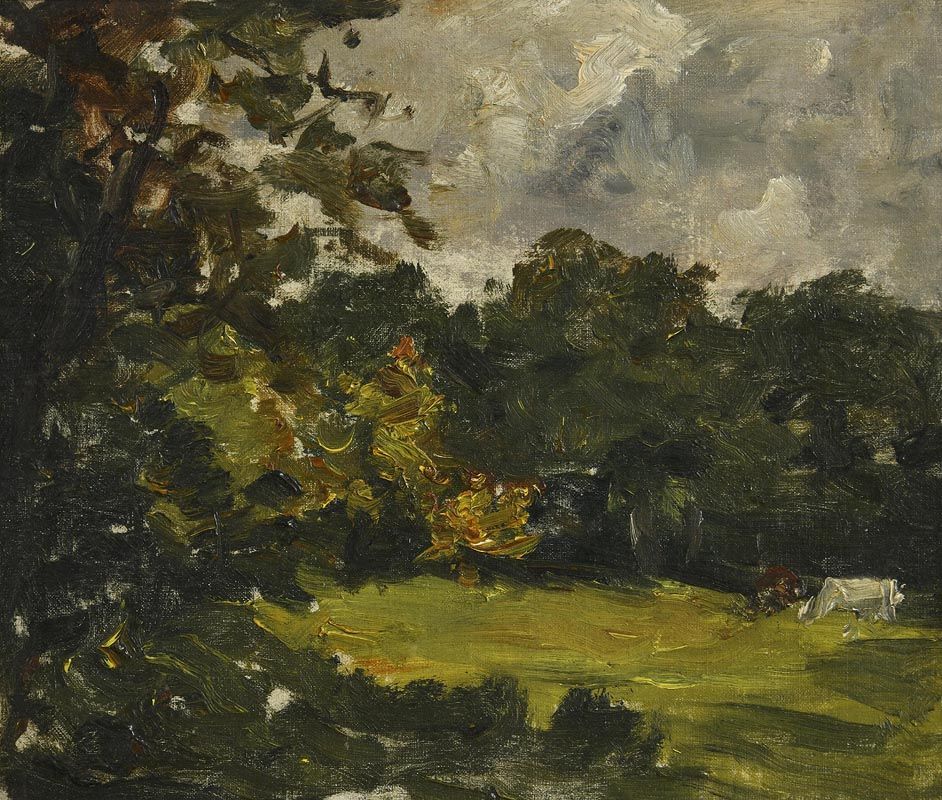
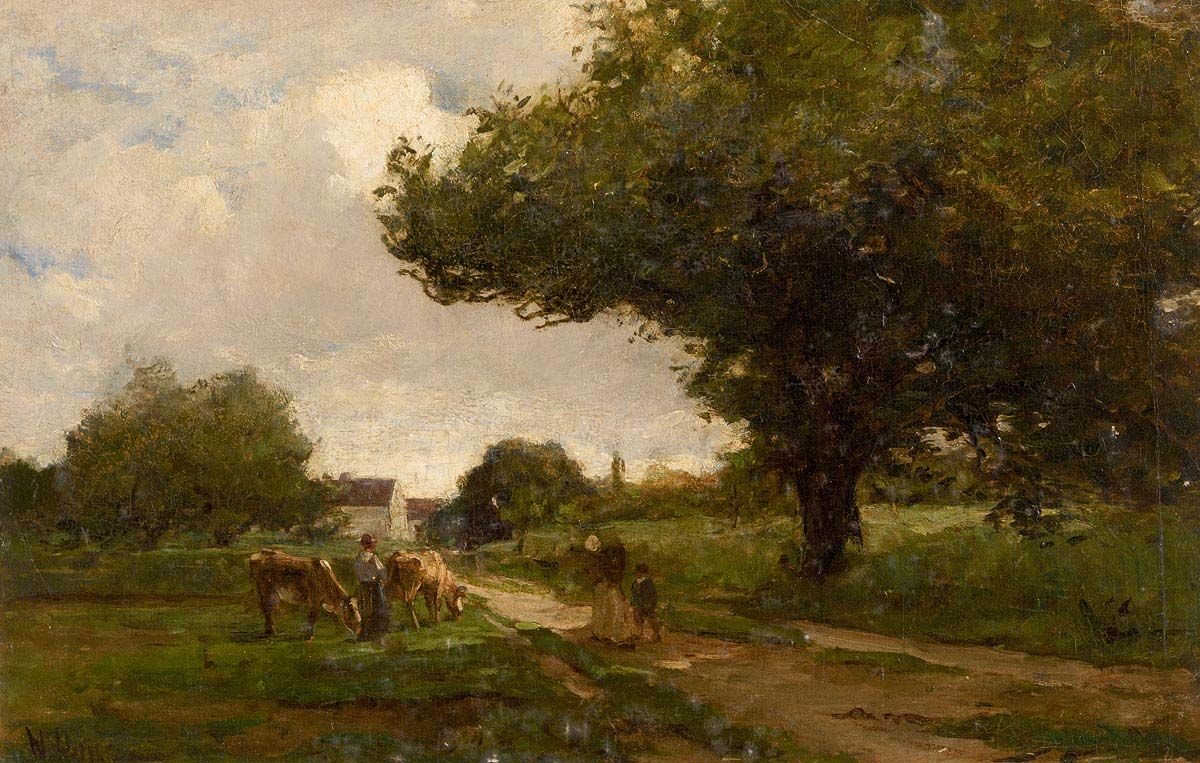
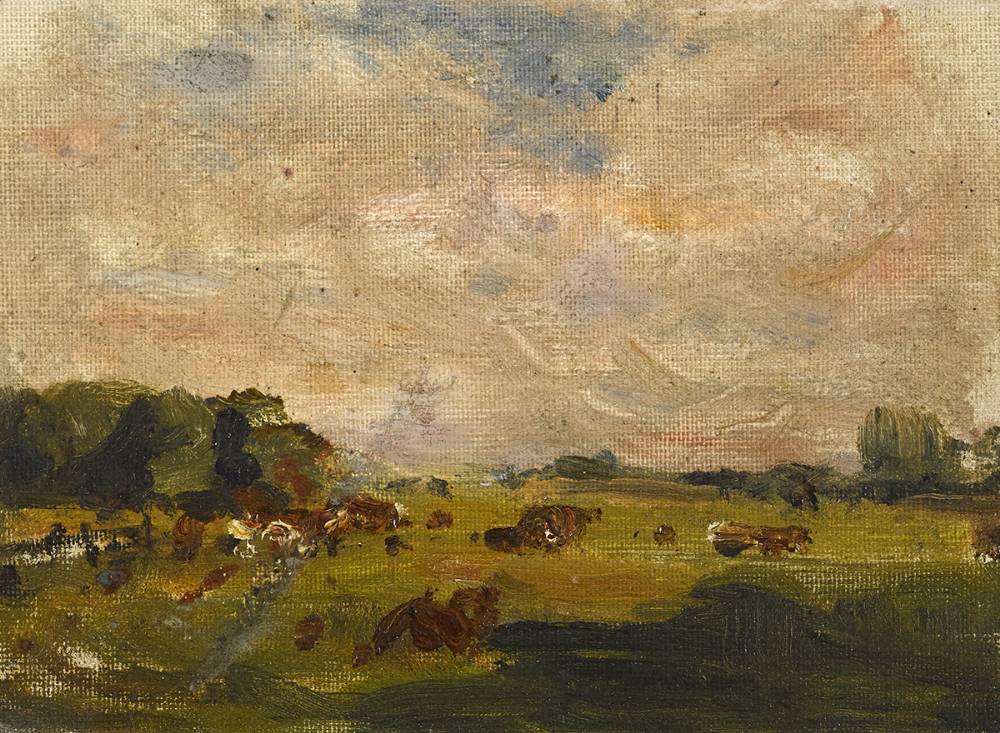

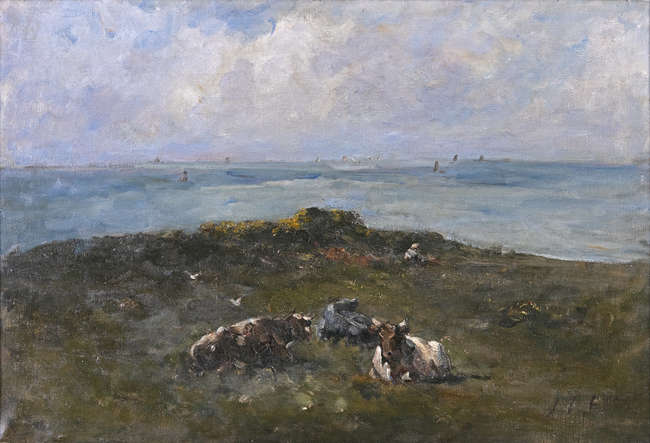

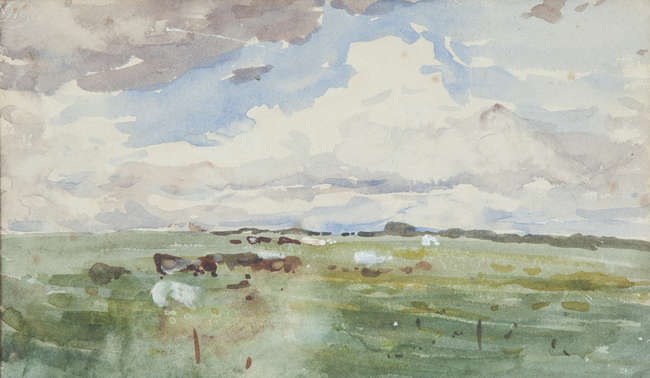



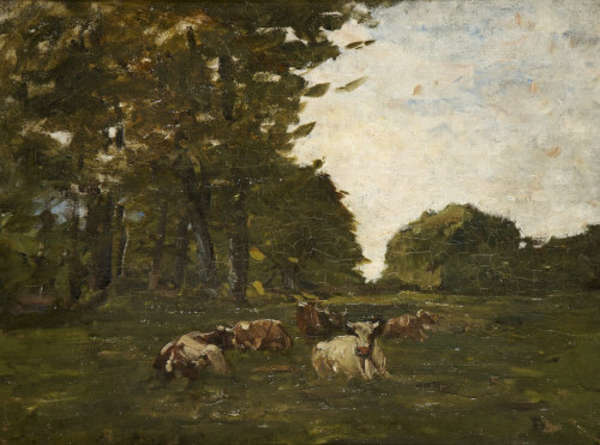
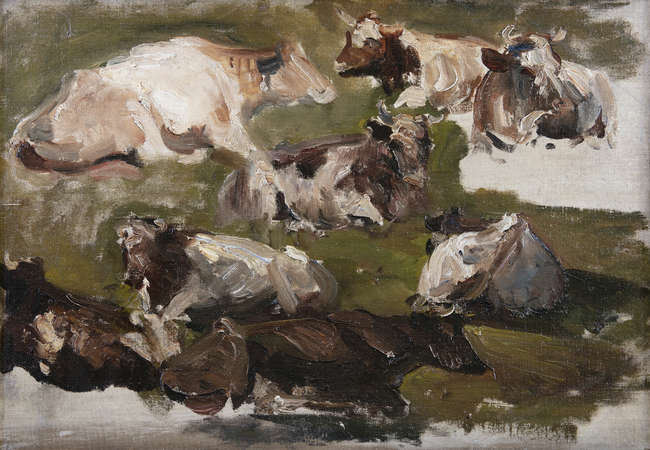
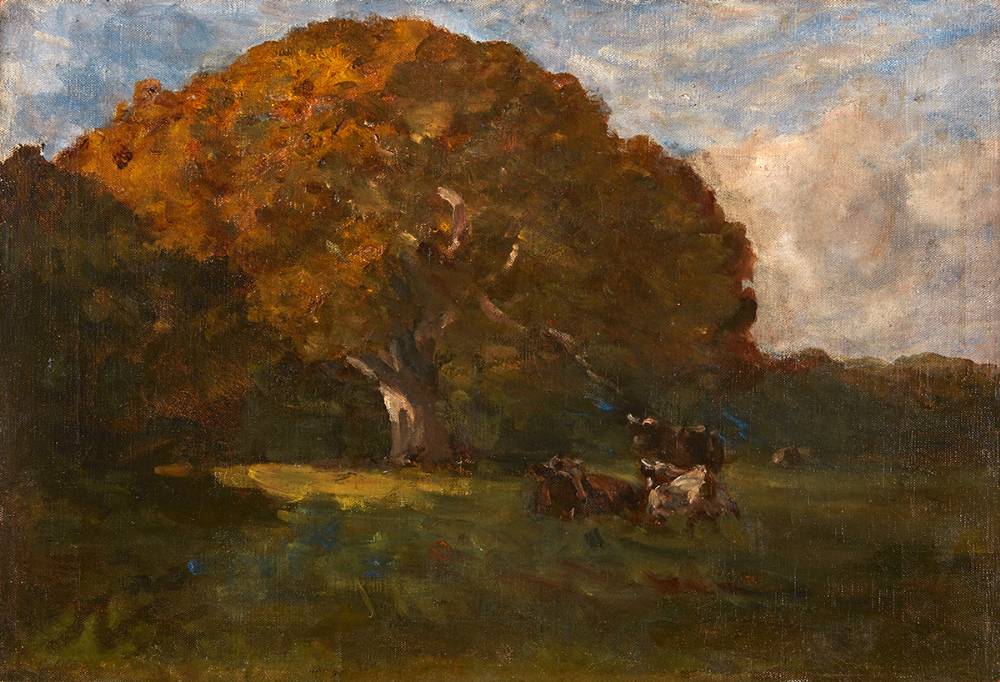
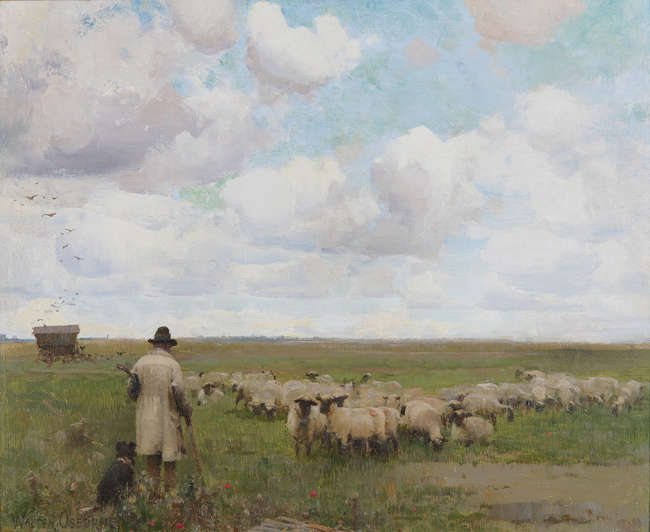
Testen Sie LotSearch und seine Premium-Features 7 Tage - ohne Kosten!
Lassen Sie sich automatisch über neue Objekte in kommenden Auktionen benachrichtigen.
Suchauftrag anlegen